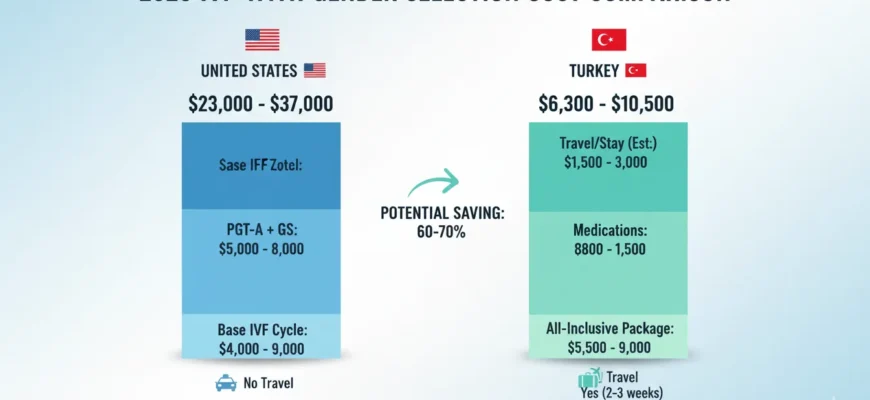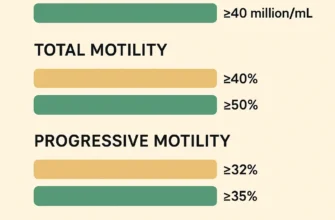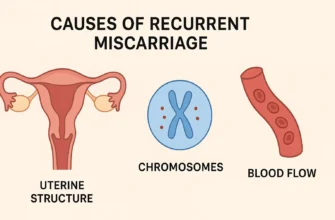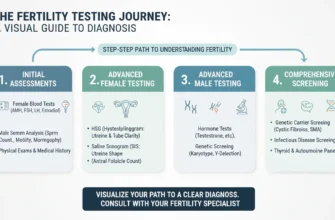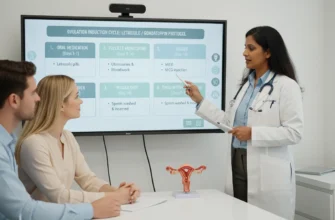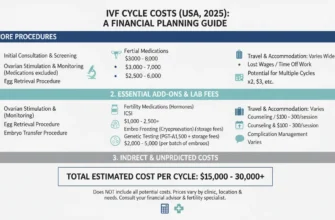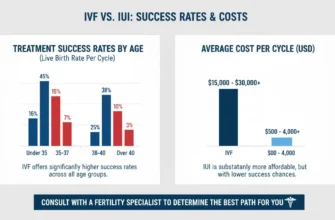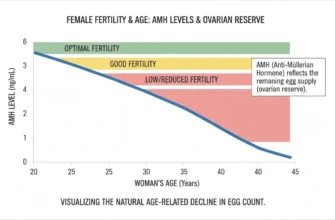Navigating the Journey of IVF Gender Selection
For many individuals and couples, the journey to building a family involves advanced reproductive technologies. In Vitro Fertilization (IVF) has opened doors for millions, and with it, the option of gender selection for family balancing or medical reasons. However, the cost of this sophisticated procedure can be a significant barrier, varying dramatically from one country to another. This financial disparity has made medical tourism a popular solution, with patients seeking high-quality medical care at a more accessible price point.
What is IVF Gender Selection and Why is it Chosen?
IVF gender selection is a process that combines standard In Vitro Fertilization with an advanced genetic testing technique called Preimplantation Genetic Testing for Aneuploidy (PGT-A). During an IVF cycle, eggs are fertilized with sperm in a laboratory to create embryos. Before an embryo is transferred to the uterus, a few trophectoderm cells (the outer layer cells that will become the placenta) are biopsied from the blastocyst stage embryo and tested to determine its chromosomal makeup, including the sex chromosomes (XX for female, XY for male).
The process typically involves Intracytoplasmic Sperm Injection (ICSI), where a single sperm is injected directly into each egg to maximize fertilization rates. The embryo biopsy is performed on day 5 or 6 after fertilization when the embryo has developed into a blastocyst containing 128-200 cells. At this blastocyst stage, embryologists can safely remove 5-10 trophectoderm cells without disturbing the inner cell mass that develops into the baby.
Modern PGT-A testing uses next-generation sequencing (NGS) technology to analyze the biopsied cells with exceptional accuracy. Older methods like fluorescence in situ hybridization (FISH) have largely been replaced by NGS due to superior reliability.
Patients choose this path for two primary reasons: medical necessity to prevent passing on gender-specific genetic disorders (such as hemophilia or Duchenne muscular dystrophy), and for non-medical family balancing purposes.
The Global Perspective: Why Location Matters for IVF Costs
The price of healthcare, particularly specialized procedures like IVF, is not uniform across the globe. Factors such as a country’s economic status, government regulations, labor costs, and the level of competition among experienced doctors and fertility clinics create vast price differences. While a fertility clinic in the United States might charge a premium due to high overheads and insurance complexities, a clinic in a destination like Turkey can offer the same quality of care at international standards for a fraction of the cost. This has positioned countries like Turkey as leading hubs for reproductive tourism.
What This Comprehensive Guide Will Cover
This guide provides a transparent, detailed breakdown of IVF gender selection costs, comparing the two distinct markets of the United States and Turkey. We will explore the science behind the procedure, dissect the factors that influence pricing, and offer a side-by-side analysis of what patients can expect to pay in each country. From core treatment fees to hidden costs, this article will equip you with the information needed to make a well-informed decision for your family-building journey.
Understanding the Science: How IVF Gender Selection Works
The ability to select the gender of a child with near-perfect accuracy is a modern medical marvel, built upon the foundation of IVF and sophisticated genetic screening. Understanding the process is key to appreciating its costs and success rates.
The IVF Cycle: A Foundation for Gender Selection
The journey begins with a standard IVF cycle. This multi-step process involves:
Ovarian Stimulation: The female patient takes fertility medications to stimulate the ovaries to produce multiple mature eggs.
Egg Retrieval: The eggs are collected from the ovaries in a minor surgical procedure under anesthesia.
Fertilization: In the lab, the eggs are fertilized with sperm. Intracytoplasmic Sperm Injection (ICSI), where a single sperm is injected directly into an egg, is often used to maximize fertilization rates and is the preferred method when PGT will be performed.
Embryo Culture and Development: The resulting embryos are grown in the lab under carefully controlled gas concentration conditions for several days until they reach the blastocyst stage (typically day 5 or 6).
Preimplantation Genetic Testing (PGT-A) for Gender Identification
This is the critical step for gender selection. Once embryos reach the blastocyst stage of embryo development, a few trophectoderm cells are carefully removed through a process called embryo biopsy. These cells are sent to a genetics laboratory where they undergo genetic analysis using next-generation sequencing technology.
This testing, known as PGT-A (Preimplantation Genetic Testing for Aneuploidy), screens embryos for chromosomal abnormalities and simultaneously identifies their sex with over 98% accuracy. Some studies report gender determination accuracy approaching 99-100% when performed under optimal laboratory conditions. Only chromosomally normal (euploid) embryos of the desired gender are selected for the embryo transfer stage. This not only facilitates gender selection but can also increase the success rate of the pregnancy by ensuring a healthy embryo is used.
The misdiagnosis rate after euploid embryo transfer is remarkably low at approximately 0.2%, meaning that fewer than 2 in 1,000 presumed euploid embryos are actually aneuploid. This exceptional accuracy makes PGT-A the gold standard for gender selection.
Success Rates and Accuracy of Gender Selection
When using PGT-A, the accuracy of gender identification is nearly 100%. However, the overall success of the IVF cycle – resulting in a live birth – depends on various factors, including the patient’s age, the quality of eggs and sperm, and the expertise of the fertility clinic.
United States Success Rates: According to data from the American Society for Reproductive Medicine (ASRM) and the Society for Assisted Reproductive Technology (SART), over 95,860 babies were born from IVF in 2023, with 432,641 cycles performed. Age-specific success rates for IVF in the USA show approximately 40-50% live birth rate per transfer for women under 35, declining to 30-35% for ages 35-37, 20-25% for ages 38-40, and significantly lower for women over 40.
Turkey Success Rates: Turkey’s IVF success rates are strong and competitive with international standards. According to recent data, Turkey achieves a 30.6% success rate for fresh cycles, 40.1% for frozen cycles, and an impressive 50.7% success rate for PGT cycles. This higher success rate for PGT cycles occurs because the process ensures only the most viable, chromosomally sound embryos are chosen for embryo transfer. The overall IVF success rate in Turkey averages around 60% for younger patients at leading fertility clinics.
That said, using PGT-A can improve outcomes by confirming hCG levels rise appropriately after transfer of genetically normal embryos, indicating successful implantation and early pregnancy development.
General Factors Influencing IVF Gender Selection Costs
The final price tag for an IVF gender selection journey is a sum of several distinct parts. Understanding these components is essential for comparing quotes from different clinics and countries.
Core IVF Treatment Fees
This is the baseline cost and typically covers the foundational procedures of a single IVF cycle. This package usually includes ovarian monitoring, the egg retrieval procedure, laboratory fees for fertilization (often including ICSI), and the embryo transfer procedure. The price can vary based on the reputation of the fertility clinic and the experience of its specialist team.
Specific PGT-A for Gender Selection Fees
This is a separate, significant cost added to the core IVF fees. The price of PGT-A covers the embryo biopsy, the complex genetic testing itself using next-generation sequencing, and the analysis performed by geneticists. The cost can fluctuate depending on the number of embryos being tested and the specific technology used by the lab. In Europe, PGT-A typically costs €1,500-€3,000, while in the USA it ranges from $4,000-$12,000.
Additional and Potentially “Hidden” Costs
Several other expenses can impact the total cost. These include:
Fertility Medications: The hormones required for ovarian stimulation can be expensive and are often not included in the initial IVF package price. Medication costs vary significantly by country.
Anesthesia: Fees for the anesthesiologist during egg retrieval may be billed separately.
Embryo Freezing (Cryopreservation): If there are additional healthy embryos of the desired gender, freezing them for future use incurs an initial cost and an annual storage fee.
Preliminary Testing: Diagnostic tests required before starting the cycle, such as blood work, ultrasounds, and hormone panels, add to the overall expense.
IVF Gender Selection in the USA: Pricing and What to Expect
The United States is a leader in reproductive technology with highly experienced doctors, but this expertise comes at a high price point, making it one of the most expensive countries for fertility care.
The High-Cost Landscape: Drivers of USA Pricing
Several factors contribute to the high cost of IVF in the USA. These include high operational and labor costs, extensive regulatory compliance, expensive medical malpractice insurance for doctors, and a complex healthcare system where insurance coverage for fertility treatments is inconsistent and often excludes gender selection for non-medical reasons.
Detailed Cost Breakdown for a Typical USA Cycle
The financial commitment for a single IVF gender selection cycle in the USA is substantial. According to recent 2025 data, “the average cost of one complete IVF cycle in the U.S. ranges from $20,000–$25,000”. When adding gender selection through PGT-A, this often breaks down as follows:
- Base IVF Cycle: $15,000 – $20,000
- PGT-A for Gender Selection: $4,000 – $7,000
- Fertility Medications: $3,000 – $8,000
- Anesthesia & Facility Fees: $1,000 – $2,000
- Total Estimated Cost: $23,000 – $37,000+ per cycle
Some clinics, like CNY Fertility, offer more affordable options with gender selection costs around $2,000 for the PGT-A component and approximately $8,000 for a complete IVF cycle including medications, bringing the total to around $10,000-$12,000. However, this represents the lower end of the pricing spectrum and is not typical for most US clinics.
Legal and Ethical Status in the USA
In the United States, gender selection for non-medical reasons is legal and widely available. The American Society for Reproductive Medicine (ASRM) considers it ethically permissible. This permissive legal environment provides patients with clear access to the service without ambiguity. According to recent US national data, the male-to-female sex ratio of neonates was significantly higher after IVF with PGT, with 164 males born for every 100 females in cycles where PGT was performed specifically for elective sex selection.
Advantages of Choosing the USA
For domestic patients, the primary advantage is convenience – no international travel is required. The USA has a highly regulated industry with stringent quality control standards maintained by organizations like SART and international standards bodies, and a high concentration of experienced specialists.
Furthermore, the number of successful IVF treatments continues to grow. According to the American Society for Reproductive Medicine (ASRM), over 95,860 babies were born from IVF in 2023, demonstrating the maturity and effectiveness of the country’s fertility sector. This represents 2.6% of all births in the United States, with 432,641 IVF cycles performed at 371 reporting SART member clinics.
IVF Gender Selection in Turkey: The Cost-Effective Alternative
Turkey has emerged as a premier destination for medical tourism, particularly for fertility treatments. It offers a compelling combination of advanced medical technology, experienced doctors, and significantly lower prices while maintaining international standards.
The Affordability Factor: Why Turkey Offers Lower Prices
The primary reason for Turkey’s affordability is its lower cost of living and operational expenses compared to the USA. This includes salaries for medical staff, laboratory running costs, and administrative overhead. The Turkish government, through the Ministry of Health, also actively supports the health tourism sector, fostering a competitive environment among clinics that helps keep prices down for international patients without sacrificing quality.
Turkey performs approximately 8% of all European assisted reproductive technology (ART) cycles, making it the 6th highest volume on the continent. The number of IVF centers in Turkey has reached over 150 and continues to increase with high demand from both national and international patients.
Detailed Cost Breakdown for a Typical Turkey Cycle
The cost savings in Turkey are dramatic. A complete IVF with gender selection package is often more affordable than just the PGT-A add-on in the USA. A typical cost breakdown is:
- IVF + ICSI + PGT-A Package: $5,000 – $8,000 (Many clinics bundle these services)
- Fertility Medications: $1,000 – $2,000
- Preliminary Tests & Consultations: $300 – $500
- Total Estimated Cost: $6,300 – $10,500 per cycle
This represents a potential saving of 60-70% or more compared to the United States. Standard IVF cycles in Turkey range from $2,500 to $5,000, illustrating the affordable base price. When PGT-A is added, comprehensive packages typically range from $5,000-$8,000, which is remarkably cost-effective.
Quality of Care and International Accreditations
Lower price does not mean lower quality. Many Turkish fertility clinics are state-of-the-art facilities with Joint Commission International (JCI) accreditation, the same body that accredits top US hospitals. They also hold ISO 15189 accreditation for medical laboratory services, ensuring excellence and international standards in testing and analysis.
Leading Turkish Fertility Centers:
Memorial Hospitals Group operates IVF centers in three locations across Istanbul: Memorial Şişli, Memorial Bahçelievler, and Memorial Ataşehir Hospital (located in Ataşehir, Istanbul). Founded in 2000, Memorial is globally renowned for excellence in fertility treatments. In 2024, Memorial Hospital successfully completed over 500 IVF cycles using patients’ own eggs. The clinic achieves up to 65% pregnancy success rates for younger couples and is staffed by over 70 experienced doctors and fertility specialists.
Memorial is home to internationally recognized experts including Prof. Semra Kahraman (heading the ART & Reproductive Genetics Unit at Memorial Şişli Hospital, globally recognized and trained at Weill Cornell and the Reproductive Genetic Institute in Chicago), Assoc. Prof. Arzu Yurci (at Memorial Bahçelievler), and Prof. Dr. Ebru Cogendez (at Memorial Ataşehir Hospital). Memorial Hospital holds ISO 15189 accreditation for laboratory services, LEED Platinum certification for environmentally friendly facilities, and JCI accreditation at multiple locations.
Anadolu Medical Center is another leading Turkish IVF provider with a state-of-the-art embryology lab equipped with advanced technologies. The center boasts an IVF success rate above 60% and a 50% blastocyst transfer rate. Anadolu Medical Center has a unique affiliation with Johns Hopkins Medicine USA, granting access to the latest medical advancements, continuous training, and unmatched expertise. The center is JCI-accredited and provides services to patients from over 65 countries worldwide.
These clinics use the latest technology and are staffed by highly trained, often European or US-educated specialists who are fluent in English. Many have patient coordinators to assist international patients throughout their journey.
Legal and Ethical Status in Turkey
Turkish law, regulated by the Ministry of Health through the “Regulation on Assisted Reproductive Treatment Practices and Assisted Reproductive Treatment Centers,” officially restricts gender selection to medical reasons and requires IVF treatment only for married heterosexual couples. However, gender selection is available to international patients at private clinics as part of comprehensive PGT-A genetic screening to ensure healthy embryos.
Clinics catering to medical tourists have well-established protocols to facilitate this service. Gender identification occurs as a natural byproduct of PGT-A testing, which primarily screens for chromosomal abnormalities. International patients should be aware that treatment requires proof of marriage, such as a marriage certificate.
Advantages of Choosing Turkey
The foremost advantage is the profound cost savings. Patients can often afford multiple cycles in Turkey for the price of one in the USA, increasing their chances of success. Other benefits include:
- Short waiting times for treatment at experienced fertility clinics
- Access to world-class medical facilities with JCI and ISO accreditation
- Highly experienced doctors trained at international standards
- Comprehensive medical care from internationally trained specialists
- The opportunity to recover in a country known for its hospitality and rich culture
- Patient coordinators who assist with all aspects of medical tourism
- Free interpretation services in multiple languages at major centers
Direct Cost Comparison: Turkey vs. USA – An “Apples-to-Apples” Breakdown
When laid side-by-side, the financial disparity between undertaking IVF gender selection in Turkey versus the USA becomes starkly clear.
Core IVF + PGT-A Package Comparison
USA: A bundled package is rare. Patients typically pay for a core IVF cycle ($15,000-$20,000) and add PGT-A ($4,000-$7,000), bringing the procedural total to approximately $20,000 – $27,000.
Turkey: Clinics catering to international patients almost always offer an all-inclusive package. This combines the IVF cycle, ICSI, and PGT-A testing for a set number of embryos for approximately $5,000 – $8,000.
Medication Cost Comparison
USA: Fertility medications are a major expense, often running between $3,000 and $8,000 per cycle.
Turkey: The same medications are available at a much lower price due to different pharmaceutical pricing structures, typically costing $1,000 to $2,000. For reference, medications in Turkey cost approximately 50% less than in the UK, with significant savings on common fertility drugs like Gonal-F and Ovitrelle.
Analysis of Potential Additional Costs
Cryopreservation of extra embryos might cost $1,000-$2,000 initially in the US, with annual storage fees of $500-$1,000. In Turkey, these fees are significantly lower, often around $500 for the initial freeze and a few hundred dollars per year for storage.
Total Journey Cost: Beyond Clinic Fees
For an international patient traveling to Turkey, the total cost must include flights and accommodation. A three-week stay can add $2,000 – $4,000 to the total bill.
Total USA Cost (for a US resident): $23,000 – $37,000
Total Turkey Cost (including travel): $8,300 – $14,500
Even with travel expenses, the savings remain substantial at 60-70%. This is why the global in vitro fertilization market is projected to reach USD 37.4 billion by 2030, driven partly by cross-border reproductive care and medical tourism.
Success Rate Comparison: USA vs Turkey
Understanding success rates is crucial when evaluating where to undergo treatment.
USA Success Rates by Age
According to 2023 SART data, IVF success rates in the United States vary significantly by age:
- Under 35 years: 40-50% live birth rate per transfer
- 35-37 years: 30-38% live birth rate per transfer
- 38-40 years: 20-25% live birth rate per transfer
- 41-42 years: 12-13% live birth rate per transfer
- Over 42 years: Under 10% live birth rate per transfer
With PGT-A, success rates for euploid (chromosomally normal) embryos range from 60-65% across age groups, as the testing ensures only healthy embryos are transferred.
Turkey Success Rates
Turkey achieves competitive success rates that meet international standards:
- Fresh cycles: 30.6% success rate
- Frozen embryo transfer cycles: 40.1% success rate
- PGT-A cycles: 50.7% success rate
- Overall IVF success rate: Approximately 60% for younger patients at leading clinics
Notably, over 99.6% of IVF cycles in Turkey are completed without serious complications like Ovarian Hyperstimulation Syndrome (OHSS), and 86% of births are healthy singletons.
A comprehensive cost-effectiveness study comparing Turkey and the USA found that using clinical pregnancy rate as the effectiveness measure, Turkey achieved approximately 37.7% success rate compared to 25.5% in the USA, while costing significantly less. The study concluded that Turkey’s cost-effectiveness ratio was at least 50% better than the US, even when accounting for variations in success rates.
Conclusion
The decision of where to undergo IVF with gender selection is deeply personal, balancing financial realities with medical needs and personal comfort. The United States offers top-tier, highly regulated care with the convenience of being local for American patients, but at a premium price that can be prohibitive for many.
In contrast, Turkey presents an exceptionally compelling value proposition. It provides access to the same advanced PGT-A technology using next-generation sequencing and high-quality clinical medical care from experienced doctors at fertility clinics that meet international standards through JCI and ISO accreditation. Leading centers like Memorial Ataşehir Hospital in Ataşehir, Istanbul and Anadolu Medical Center offer world-class treatment at a price point that is 60-70% lower than in the US.
The Turkish Ministry of Health regulates fertility treatments to ensure safety and quality, while experienced specialists like Prof. Semra Kahraman and Assoc. Prof. Arzu Yurci provide expertise comparable to top US centers. With success rates exceeding 50% for PGT cycles and overall rates around 60% at premier clinics, Turkey delivers both quality and value.
For many patients, the significant cost savings mean the difference between being able to afford one cycle versus multiple, directly impacting their probability of achieving a successful pregnancy with appropriate hCG levels confirming implantation. The ability to have embryos develop to the blastocyst stage under optimal gas concentration conditions, undergo precise trophectoderm cell biopsy, and receive testing by experienced laboratory personnel at international standards makes Turkey an increasingly popular destination.
For those considering this journey, the next steps are clear. Conduct thorough research into accredited clinics in both countries. Schedule consultations with experienced doctors to discuss your specific case, and request detailed, all-inclusive price quotes. Read patient reviews from a patient coordinator and ask for success rate data specific to your age group. By weighing the costs, quality of medical care, and logistical considerations, you can make an empowered choice that best aligns with your family-building goals and financial circumstances.

